Instill accountability for safety and risk management
Safety Consulting
Safety Gap Model
Do You Have a Accountability Gap?
Do you see this at your company?
- Lack of company or individual accountability
- Low employee morale
- Employees don’t feel valued
- Lack of employee engagement
- Negative employee feedback
- Lack of safety ROI
Warning: You could have an accountability gap in your safety program.
The accountability gap is the gap between safety behavior and recognizing and addressing the behavior. This leads to a lack of accountability or repercussions.
Why this gap exists:
- Lack of defined responsibility
- Poorly defined safety processes.
- Failure to regularly update safety process standards.
How to Solve for an Accountability Gap
Accountability programs keep individuals, groups, and a company accountable. Using a carrot and stick method, we work with companies to incentivize positive behavior and reprimand negative behavior, both at the individual and company level. Our consulting services include accountability programs, safety committee meetings, and a completely outsourced safety program.
Consulting Services
Workplace safety can encompass everything from compliance to culture. For companies focused on being profitable while minimizing business risk, you’ll be interested in how safety consulting services can help you achieve those goals.
We look at your safety program as a whole: from on-site hazard identification to accountability programs for the company to implementing key activities known to reduce accident rates and insurance costs.
Here are the consulting services we provide:
- Accountability Programs
- EMOD Monitoring
- Incentive Programs
- Loss Runs Analysis
- Outsourced Safety Consulting
- OSHA 300 Logs
- Safety Committee Meetings
- Safety Committee Organization
- Safety Culture Outline
Outsourced Safety Consulting
Changing Safety Behavior: Negative Reinforcement vs. Punishment
Many people confuse the terms negative reinforcement and punishment, thinking they mean the same thing.
But they don’t. At least not in human psychology.
Reinforcement, in general, is proactive and strengthens involuntary responses. There are both positive (receive something) and negative (remove something) reinforcements.
- An example of positive reinforcement: if a job crew achieves a zero-incident month, each member will receive a paycheck bonus.
- An example of negative reinforcement: if a job crew achieves a zero-incident quarter, we’ll hire another crew member to help with the more tedious parts of the project.
Reinforcement is adding or removing something that would encourage a response to happen again
In contrast, punishment is reactive and weakens voluntary responses. There are also both positive (receive something) and negative (remove something) punishments.
- An example of positive punishment: filling out additional forms to continue to move forward with the job.
- An example of negative punishment: unpaid leave after displaying bad behavior.
Punishment is either adding or removing something that would stop a response from happening again.
To get more plain language safety tips and advice in your inbox, subscribe to our newsletter here.

Where Are Your Safety Gaps?
At Insure Compliance, we follow our Safety Gap Model to bridge the safety gaps in your business.
When each of the five gaps are addressed, you create a positive safety culture for your company and successfully minimize your business risk in terms of safety and insurance.
Meet our team
Insure Compliance is constantly growing and learning. Find out more about our incredible team of safety professionals.
